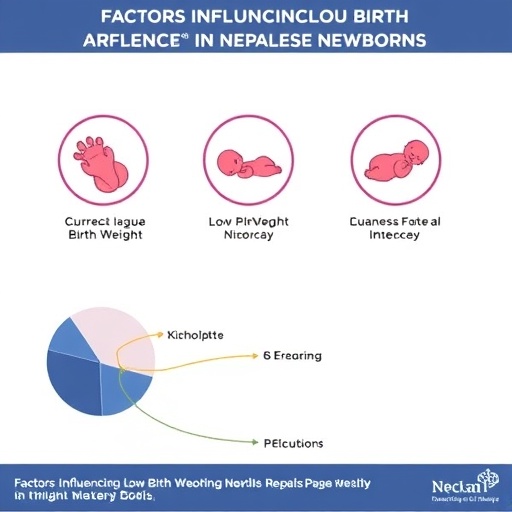In the heart of western Nepal, a concerning health issue has drawn researchers’ attention: low birth weight (LBW) among newborns. Recent findings from an unmatched case-control study underscore the alarming prevalence of this condition, which poses serious risks for both neonates and their mothers. This study, undertaken at a prominent referral hospital, reveals various determinants that affect birth weight, prompting local and international healthcare communities to reevaluate strategies aimed at mitigating this public health concern.
Low birth weight is defined as a birth weight of less than 2,500 grams, regardless of gestational age. Factors contributing to LBW are multifaceted, often entwining socioeconomic, nutritional, and healthcare-related elements. The ramifications of LBW are profound, including increased susceptibility to neonatal morbidity and mortality, long-term developmental disadvantages, and chronic health issues as children grow. Understanding the underlying determinants is crucial in addressing this pervasive health problem.
The researchers, Dhungana, Dhungana, and Fassl, meticulously conducted their study to highlight these determinants in the context of a referral hospital setting epitomizing the challenges in western Nepal. This geographical region, known for its rugged terrain and limited access to healthcare facilities, showcases significant health disparities that contribute to poor maternal and child health outcomes. The disparities are exacerbated in rural areas where resources and education about prenatal care are scarce.
Amidst these challenges, the research team focused on elucidating the quantifiable factors—including maternal age, education level, nutritional status, and socioeconomic background—that correlate with low birth weight cases. In particular, the study highlights that younger maternal age is frequently linked with increased rates of LBW. Young mothers may lack the emotional maturity, economic stability, and nutritional knowledge necessary to ensure healthy pregnancies, thereby increasing the risks for their newborns.
Maternal nutrition remains a critical component of this discussion. A proper diet significantly influences fetal development, and deficiencies in essential micronutrients can lead to undernourishment. The study found a strong correlation between inadequate maternal nutrition and incidences of LBW, reinforcing the need for effective nutritional programs targeting expectant mothers. In resource-limited settings, access to healthy food is often a barrier that affects many pregnant women.
Education plays a pivotal role in addressing LBW as well. The study details that mothers with a higher educational background tended to have better health outcomes for their children. Education equips women with the knowledge to seek appropriate prenatal care and make informed dietary choices. Thus, initiatives that promote female education, particularly in rural communities, could have a cascading effect on improving newborn health and reducing LBW prevalence.
Further examining the healthcare system itself reveals that access to and quality of prenatal care serve as crucial determinants. Many women in western Nepal face obstacles in accessing healthcare services due to geographical constraints and inadequate transportation facilities. The study emphasizes that addressing these access issues is imperative. Enhanced healthcare infrastructure and community outreach programs could significantly improve prenatal care uptake, thus possibly lowering LBW rates.
The implications of this study extend beyond immediate health concerns; they call for integrated strategies that involve various sectors to tackle the underlying causes of LBW comprehensively. For example, community health workers play a vital role in bridging the gap between pregnant women and healthcare resources. Training and deploying these workers effectively could facilitate better maternal care initiatives tailored to local needs.
Furthermore, the research team emphasizes the importance of policy-level interventions that offer protective mechanisms for vulnerable populations. By implementing comprehensive maternal health policies that address nutrition, education, and healthcare access, stakeholders can create an environment conducive to healthier pregnancies. Collaboration among government bodies, non-governmental organizations, and community leaders is essential in fostering these changes.
As the global community grapples with health inequalities, studies such as this one shed light on specific regional challenges. The findings underscore that LBW is not merely a statistic; it is a reflection of the broader sociocultural and economic fabric of a society. By fostering awareness and taking concrete actions based on such research, there lies potential for profound change that could save countless lives.
The evidence presented by Dhungana and colleagues serves as both a wake-up call and a blueprint for action. The urgent need for targeted interventions aimed at reducing LBW is clear and pressing. Continued research in varied contexts can propagate understanding and highlight successful strategies that can be employed in similar settings worldwide.
Ultimately, the determinants of low birth weight illustrated in this study not only serve to inform future research but also highlight collaboration on maternal and child health issues. As we move forward, integrating the insights of this research into real-world actions will be fundamental in reversing the tide of low birth weight cases and ensuring healthier futures for mothers and their newborns.
In conclusion, addressing low birth weight in Nepal and beyond requires multifaceted solutions drawing from education, nutrition, healthcare access, and policy reforms. By understanding the complex interplay of these determinants, stakeholders can work collectively to tackle the challenge head-on, fostering healthier generations for years to come.
Subject of Research: Determinants of low birth weight in newborns
Article Title: Determinants of low birth weight in newborns at a referral hospital in the western Nepal: an unmatched case-control study.
Article References:
Dhungana, R., Dhungana, A., Fassl, B. et al. Determinants of low birth weight in newborns at a referral hospital in the western Nepal: an unmatched case-control study.
BMC Pediatr 25, 778 (2025). https://doi.org/10.1186/s12887-025-06158-7
Image Credits: AI Generated
DOI:
Keywords: Low birth weight, maternal health, nutrition, education, healthcare access, socioeconomic factors, Nepal.
Tags: case-control study on LBWdeterminants of low birth weightdevelopmental disadvantages of low birth weighthealth disparities in western Nepalhealthcare access in rural Nepallow birth weight in Nepalmaternal health in Nepalneonatal health challenges in Nepalneonatal morbidity and mortalitynutritional influences on birth weightpublic health strategies for LBWsocioeconomic factors affecting birth weight





